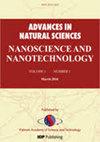Red-emitting and antibacterial carbon dots for cellular imaging and skin wound healing
IF 2.1
Q3 MATERIALS SCIENCE, MULTIDISCIPLINARY
Advances in Natural Sciences: Nanoscience and Nanotechnology
Pub Date : 2023-03-01
DOI:10.1088/2043-6262/acc453
引用次数: 2
Abstract
Carbon dots (CDs) as a new type of fluorescent nanomaterials have attracted considerable attention from researchers in chemistry, biology, and materials science. Here, we employed a hydrothermal method for synthesis of red-emitting and antibacterial CDs displaying an excitation-independent emission characteristic with a maximum emission intensity at 610 nm (pH 7.4). The synthesised CDs exhibited a high capability for bioimaging in HeLa cells, because of their negligible cytotoxicity and acceptable red photoluminescence. Moreover, the antibacterial activity of CDs against P. aeruginosa was studied and showed a minimum inhibitory concentration (MIC) of 256 μg ml−1. Further experimental results showed the high ability of the CDs to heal skin wounds in the rat model. According to the observations, wound healing in the presence of the CDs was calculated four days faster with 20.48% better performance than the control group.发光和抗菌碳点用于细胞成像和皮肤伤口愈合
碳点作为一种新型的荧光纳米材料,受到了化学、生物学和材料科学等领域的广泛关注。本研究采用水热法合成了红致发光和抗菌CDs,其发光特性与激发无关,最大发射强度在610 nm (pH 7.4)。合成的CDs在HeLa细胞中表现出很高的生物成像能力,因为它们的细胞毒性可以忽略不计,并且可以接受红色光致发光。此外,研究了CDs对铜绿假单胞菌的抑菌活性,发现其最低抑菌浓度(MIC)为256 μg ml−1。进一步的实验结果表明,cd对大鼠皮肤创伤具有良好的愈合能力。根据观察,在cd存在的情况下,伤口愈合的计算速度比对照组快了4天,性能提高了20.48%。
本文章由计算机程序翻译,如有差异,请以英文原文为准。
求助全文
约1分钟内获得全文
求助全文
来源期刊

Advances in Natural Sciences: Nanoscience and Nanotechnology
NANOSCIENCE & NANOTECHNOLOGYMATERIALS SCIE-MATERIALS SCIENCE, MULTIDISCIPLINARY
自引率
4.80%
发文量
0
 求助内容:
求助内容: 应助结果提醒方式:
应助结果提醒方式:


